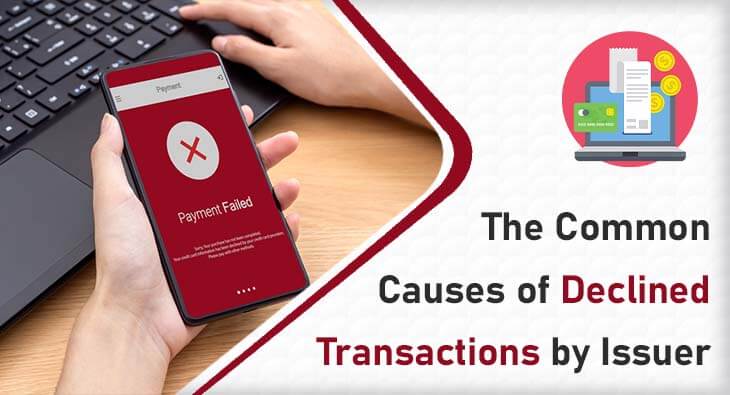High-risk merchants are all too familiar with Declined Transactions by Issuer. Unfortunately, there are a variety of reasons why a customer’s transaction may be declined and it can be difficult to determine the exact cause. In this blog post, we’ll provide an overview of some of the most common reasons for declined transactions by issuer. We’ll cover everything from input errors to insufficient funds so that merchants can better understand the possible causes of a declined transaction.
What is a High-Risk Merchant Account?
A high-risk merchant account is specifically designed for businesses that operate in industries with a higher level of risk, such as online gambling, adult entertainment, or pharmaceuticals. These accounts are necessary because traditional payment processors may not be willing to provide services to businesses in these industries due to the increased likelihood of chargebacks or fraudulent activity. High-risk merchant accounts typically come with higher fees and stricter terms and conditions to mitigate the potential risks associated with these businesses. Despite the challenges, having a high-risk merchant account is crucial for businesses in these industries to accept credit card payments and grow their customer base.
Some Related Blogs
- Payment Habits of Young Adults: Look at Trends and Patterns
- Unlocking the Benefits of Adult Dating Merchant Account
- Protecting High-Risk Transactions with a Merchant Account
- Key Considerations for Opening a Merchant Account
Why are Transactions Declined by Issuers?
When it comes to declined transactions by issuers, there are several factors at play. One of the main reasons is the possibility of fraudulent activity or suspicious transactions. Issuers have advanced systems in place to detect and prevent fraud. Which can sometimes result in legitimate transactions being declined. Another common cause is insufficient funds in the customer’s account, leading to a declined transaction. Input errors, such as incorrect card details or expiration dates, can also trigger a decline. Understanding these reasons is essential for high-risk merchants to navigate the challenges of declined transactions and find solutions to minimize their occurrence.
Common Causes of Transaction Declines
Transaction declines can occur for a variety of reasons, and understanding these common causes is essential for high-risk merchants. One reason is the possibility of fraudulent activity. Where issuers have sophisticated systems to detect and prevent fraud.
![]()
Email us anytime!
Email customer service 24/7
![]()
Call us anytime!
Reach customer care 24/7 at +1 (727) 330-3944
Another common cause is insufficient funds in the customer’s account, resulting in a declined transaction. Input errors, such as incorrect card details or expiration dates, can also trigger a decline. By being aware of these common causes. High-risk merchants can take proactive steps to minimize declined transactions and provide a smoother payment experience for their customers.
Fraudulent Transactions
Fraudulent transactions can be a major concern for high-risk merchants. Issuers have sophisticated systems in place to detect and prevent fraud, but sometimes legitimate transactions can get caught in the crossfire. This can result in frustrating declines for both merchants and customers. It’s important for high-risk merchants to be aware of the signs of potential fraud and take steps to protect their businesses. Implementing additional security measures, such as 3D Secure or CVV verification. Can help reduce the risk of fraudulent transactions and provide peace of mind for merchants and customers alike.
Chargebacks and Disputes
Chargebacks and disputes can be a major headache for high-risk merchants. A chargeback occurs when a customer disputes a transaction and asks their bank to reverse the payment. This can happen for various reasons, such as unauthorized transactions, goods not received, or dissatisfaction with the product or service. Chargebacks can result in lost revenue, additional fees, and damage to a merchant’s reputation. It’s important for high-risk merchants to have strong customer service protocols in place to address any issues or concerns promptly. By effectively managing chargebacks and disputes, merchants can maintain customer satisfaction and minimize the impact on their business.
False Positive Transactions
False positive transactions are another challenge that high-risk merchants may encounter. These are legitimate transactions that are mistakenly flagged as fraudulent by the issuer’s detection systems. False positives can result in unnecessary declines and frustrations for both merchants and customers. High-risk merchants need to be aware of this issue and work closely with their payment processors to fine-tune their fraud detection systems and minimize false positives. By doing so, merchants can ensure that legitimate transactions are approved and avoid unnecessary disruptions to their business operations.
Solutions for Reducing Transaction Declines
To reduce transaction declines, high-risk merchants can implement a few key strategies. First, it’s important to ensure that the customer’s payment information is accurately entered and up-to-date. Providing clear instructions and error-checking mechanisms can help minimize input errors. Additionally, merchants should consider implementing additional security measures, such as 3D Secure or CVV verification, to reduce the risk of fraudulent transactions. Working closely with payment processors to fine-tune fraud detection systems and minimize false positives is also crucial. By taking these proactive steps, high-risk merchants can significantly reduce the occurrence of declined transactions and provide a smoother payment experience for their customers.


